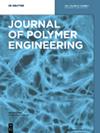对聚酰胺 66 圆柱齿轮不同加载条件下失效模式的实验分析
IF 1.7
4区 工程技术
Q4 POLYMER SCIENCE
引用次数: 0
摘要
工程塑料越来越多地用于汽车、电动汽车和家用电器等领域的传动系统。齿轮系统的基本任务是将动力从源头有效地传递给应用用户。工程塑料在齿轮传动应用中的使用条件是缺乏材料对的摩擦学特性,而摩擦学特性会影响整个齿轮传动系统的疲劳和磨损行为。本文对钢/聚酰胺 66 齿轮进行了测试,确定了无限区域内的疲劳寿命,并考虑了微米级精度的高精度光学测量,测量了齿面磨损和接触表面温度,为工程师提供了一个重要的数据库,以了解材料是否适用于适当的机械系统。从结果来看,PA66 HT 的齿面磨损与啮合温度和扭矩成正比。热熔是聚合物齿轮在较高负载水平下的特征失效模式。在中等扭矩下,主要的失效模式是齿面断裂,即节点断裂。齿轮磨损机制的更大影响发生在较低扭矩时,初始裂纹扩展始于节距点,止于齿根区域。本文章由计算机程序翻译,如有差异,请以英文原文为准。
Experimental analysis of failure modes depending on different loading conditions applied on cylindrical polyamide 66 gears
Engineering plastics are increasingly used for gearing systems, such as in the automotive sector, e-mobility sector, and household appliances. The basic task of the gearing system is to efficiently transfer power from the source to the application user. The use of engineering plastics for gearing applications is conditioned by the lack of tribological characteristics of material pairs which influence on fatigue and wear behaviour of the whole gearing system. The paper presents testing of the steel/Polyamide 66-gear by determining fatigue life in an infinite area, considering high precision optical measurements in the range of micro-meter accuracy of abrasion flank wear together with surface temperature in contact, providing an important database for engineers about material suitability for appropriate mechanical systems. Observing the results, gear flank wear of PA66 HT is directly proportional to the meshing temperature and torque. Thermal melting is a characteristic failure mode of the polymer gears which are exposed to higher load levels. In the middle torques, the dominant failure mode is flank fracture known as pitch point fracture. The greater impact of the gear wear mechanism occurs at lower torques where initial crack propagation starts at the pitch point and ends in the tooth root area.
求助全文
通过发布文献求助,成功后即可免费获取论文全文。
去求助
来源期刊

Journal of Polymer Engineering
工程技术-高分子科学
CiteScore
3.20
自引率
5.00%
发文量
95
审稿时长
2.5 months
期刊介绍:
Journal of Polymer Engineering publishes reviews, original basic and applied research contributions as well as recent technological developments in polymer engineering. Polymer engineering is a strongly interdisciplinary field and papers published by the journal may span areas such as polymer physics, polymer processing and engineering of polymer-based materials and their applications. The editors and the publisher are committed to high quality standards and rapid handling of the peer review and publication processes.
 求助内容:
求助内容: 应助结果提醒方式:
应助结果提醒方式:


